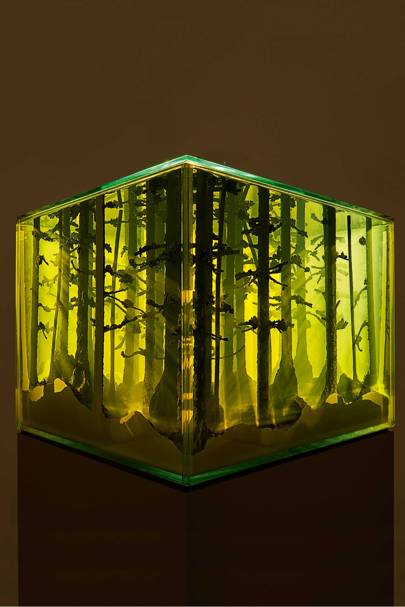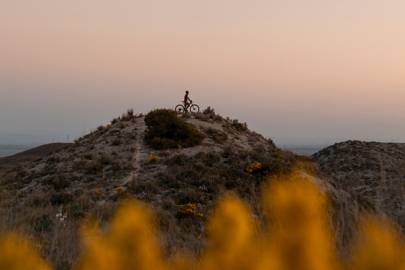- THE RISE OF REGAL ARCHITECTURE
- We’ve been crushing on palatial design for a while now – from the lavish sets on The Crown to the knowing new chintz epitomised by designers such as Martin Brudnizki (Annabel’s in London) and Laura Gonzalez (Paris’s Lapérouse restaurant). At the dawn of the 2020s, though, only living like a royal will do. In 2020 Edinburgh specialist Lateral City opened nine apartments in Abbey Strand at Holyrood Palace – the Queen’s official residence in Scotland – with a physic garden redesigned by Prince Charles.Meanwhile, Jaipur’s City Palace – its pink façade is straight out of one of Wes Anderson’s more fantastical dreams – became the first royal home to list on Airbnb. The 21-year-old maharajah is offering stays in the baby-blue Gudliya Suite, with proceeds helping women’s charities. And in late 2021, Six Senses’ first Indian foray will be set in a 14th-century fort once owned by the Rajasthani royal family, with a design that’s heavy on marbled splendour.But few openings will be as buzzed-about as 2021’s 14-room Airelles Le Grand Contrôle, in the old financial controller’s building at the Palace of Versailles. ‘We want it to feel like you’re walking into the 18th century,’ says interior designer Christophe Tollemer, who has taken primary inspiration from Marie-Antoinette’s Le Petit Trianon and has gone all-out for period accuracy, using only original furniture.As in Louis XIV’s time, the grandest suites will be on lower floors (the staff lived upstairs). Guests will have exclusive access to the palace after the hordes depart. But even the bombastic king didn’t have a spa and an Alain Ducasse restaurant. The poor chap. Toby SkinnerALAMY
THE SURPRISING THINGS HAPPENING IN THE UK’S FORESTSOnce upon a time, the world was almost all forest. It grew into a place to be feared and worshipped, a place of escape. Ancient myths and fairy tales emerged from the bracken, pursued by modern horror. The crack of broken twigs; the trail of breadcrumbs beneath the boughs. Over the past century, though, the main narrative has been one of disappearance – of out-of-control logging, wildlife in retreat, fires raging. And, of course, these areas are needed now more than ever, an issue addressed by Among the Trees, the spring 2020 show at London’s Hayward Gallery, where pieces by Tacita Dean, Steve McQueen and others explored the symbiotic role woods play in shaping civilisations.An open-cast mine in the Midlands an hour away is becoming the Young People’s Forest, encouraging youthful volunteers to dig in and plant saplings. And as the meditative philosophy of shinrin-yoku – forest bathing – reaches peak mindfulness, other ventures celebrate the transformative power of trees. In France, Loire Valley Lodges in protected woodland is an immersive retreat; while The Forest BIG in Taiwan is a striking nature-study space set in a rewilded former theme park. In Norway, meanwhile, a specially grown plantation is providing raw material for the Future Library project, an artwork of 100 original stories by authors such as Margaret Atwood, not to be printed or read until 2114. Until then, the sleeping-beauty manuscripts, one of which is written every year, will take up residence in Oslo’s new sustainably minded library. It’s an exercise in long-term environmental thinking: a concept that trees are all too familiar with.PHOTO: BENJAMIN JONES ARTWORK CREDIT: MARIELE NEUDECKER AND THEN THE WORLD CHANGED COLOUR: BREATHING YELLOW, 2019
- MIXED MEDIA INCLUDING WATER, ACRYLIC, SALT, FIBREGLASS, SPOTLIGHT
- 64 X 57 X 165 CM © MARIELE NEUDECKER 2020 ALL RIGHTS RESERVED, DACS 2020. COURTESY PEDRO CERA AND THE ARTIST
BOARD GAMES ARE BOUNCING BACK ACROSS THE WORLDSeason three of Stranger Things was the one with the shopping mall and the return of the Mind Flayer – but it was also the one in which Will Byers kept plaintively asking his friends, ‘Can we just play Dungeons & Dragons now?’ This fantasy classic came of age in the 1980s and since its appearance in the retro-nostalgia TV show its role-play has been quickly adopted by not-around-the-first-time millennials. But this isn’t the only box in the cupboard.Tabletop gaming is flourishing, and dusty rule books from old-school hits such as Cluedo, Risk and Monopoly have been torn up: rather than just rolling dice and plonking counters around, the new generation of games focuses on more female characters, collaboration over conflict, and evolution.In addition to Catan (building settlements and trading), the most influential are Carcassonne (creating a medieval landscape) and Ticket to Ride (connecting cities by rail), each involving maps and an element of travel – the latter around the golden age of steam or, in newer versions, the New York Subway and Swinging Sixties London. Then there’s Dawn of Worlds, in which everyone creates a map and storyline together; Ishtar, for planting trees in the desert; Paupers’ Ladder, based in an alternative Brighton, and Tokaido, pictured, a gentle pilgrimage set in Japan in which the aim is, well, to try to have a nice day – go for a walk, visit a teahouse.In the unfortunately topical Pandemic, players with different skill sets – scientist, medic – team up to vanquish a series of global infections. ‘That sense of working together to solve problems, coming up with a plan, is why I play board games,’ says Christopher Eggett, whose Tabletop Gaming magazine is behind the UK’s newest festival dedicated to them. ‘They can be discursive, almost like parlour games or escape-room puzzles, and one way of connecting people that doesn’t have to revolve around alcohol.’ While fans continued online during lockdown via Tabletop Simulator, gaming bars and cafés – Snakes & Lattes in Toronto, Café Meisia in Paris – are hoping to open again soon. They’re not only meeting places for like-minded travellers, but also testing grounds for ideas created by players to be crowd-funded into a box of their own. Your turn…TOKAIDO DESIGNED BY ANTOINE BAUZA
RETRO AIRSHIPS ARE HAVING A RENAISSANCEThe game of historical ‘What if?’ is a favourite pastime among academics and screenwriters alike. How would the world have turned out if Napoleon had never been defeated, or Kennedy never assassinated? Another question is: supposing the airship hadn’t crashed and burned in the 1930s but instead taken off as an everyday mode of transport? Propellers whirring, these silent leviathans of the stratosphere glide through parallel universes in fantasy fictions such as His Dark Materials and Doctor Who, but now they’re returning to our own timeline.In a race similar to those goggle-eyed rivalries of early aviation, several contenders are vying to reinflate the zeppelin’s reputation, using helium rather than highly flammable hydrogen, and emitting up to 90 per cent less carbon than conventional aircraft.In France, Flying Whales is readying a cargo vessel for lift-off in 2023, able to unload its freight without touching down and serve remote communities. On this side of the Channel, Hybrid Air Vehicles – which adds wings to the familiar blimpish dirigible – is preparing to carry travellers on short hops in its Airlander 10, pictured. Across the Irish Sea, for example, or from Las Vegas to the Grand Canyon. ‘They can land on any flat surface or water, so don’t need an airstrip – they can go anywhere,’ says Tom Grundy of the Bedfordshire-based outfit.Another destination, for which tickets are already being sold, is the Arctic. In the frost-lipped story of polar exploration, it’s often forgotten that the first flight over the North Pole was in an airship called Norge in 1926, which had Roald Amundsen on board. Floating low and slow, the new OceanSky trip will take 16 passengers from Svalbard across the icy wastes, the only sound the rushing of the wind outside. There will be a chef, and a glass-floored viewing bar. But not, as there was on the ill-fated Hindenburg, a smoking room.HYBRID AIR VEHICLES LTD.
OUTDOOR PURSUITS: ROUGH CYCLINGMAMILs’ – Middle-Aged Men In Lycra – may not yet be endangered, but their population is no longer booming. The otter-sleek Wiggins wannabes, oft-spotted on the edges of Surrey’s A3100, are being replaced by a new generation eager to get off the tarmac.‘Rough stuff’ is the catch-all term for a different kind of cycling, often on hybrid adventure or gravel bikes which have drop handlebars like the road version but are sturdier, able to traverse muddy bridleways and mountain passes. The new rough cyclist might go on bikepacking trips, where clunky panniers are out and lightweight Rapha frame bags are in, to tour the trails around Girona or the mountains of Kyrgyzstan.This tribe is merely the latest, though. The world’s oldest off-road bike club, the Rough-Stuff Fellowship, was founded in 1955. Rides may have included heading to Everest base camp or through Iceland on rudimentary touring bikes, but are as likely to involve a pootle across a Peak District fen for tea and scones.Membership has doubled over the past year, partly the result of the group collating its archive of bucolic pre-Lycra photographs into a book and joyous Instagram account. ‘It’s less competitive than road- or mountain biking; more about nature and community,’ says Max Leonard, a cycling journalist and author, and recent RSF member. ‘There’s no dogma, it’s very inclusive. It’s that feeling of riding you have as a kid. Just freedom and fun.’STOCKSY
MUSHROOM FARMS ARE THE CURIOUS MUST-HAVE ADDITION FOR ECO HOTELSLike a cloud of spores drifting through a woodland clearing, the uses of fungi are myriad and marvellous. They’ve become something of a poster child for plant-based food, and are a necessary part of fermentation. Psilocybin, the psychedelic compound in magic shrooms, is being microdosed to boost creativity at wellness retreats such as Synthesis in the Netherlands.And while home-growing kits have been a lockdown hit, a mushroom farm has become almost compulsory for any hotel seeking to prove its eco credentials: at Battlesteads in Northumberland it’s in a shipping container; The Newt in Somerset grows oyster mushrooms on straw; the Maldives’ Soneva Fushi has a hut with a resident mycologist; and The Standard East Village in New York added a little plot to its café – neon-lit like a fish tank. They’re even colonising disused underground car parks across Paris.‘You can set one up almost anywhere,’ says Adam Sayner of urban farmers GroCycle. ‘I’ve seen one on the third floor of an office block – it can be quite a surprise to draw the curtain aside.’Of course, if you’re a mushroom, you’ve probably heard all this before on the so-called Wood Wide Web, the subterranean network that allows trees and plants to communicate with each other, formed from mycelium. It’s a substance that is being adopted by designers to create footwear and furniture, as well as a leather-like material known as Reishi and made by LA-based MycoWorks. Admirable, but not quite as impressive as the boat crafted from mycelium by a student in Nebraska. Christened Myconoe, it took only 14 days to grow and has already been on several voyages. The future of sustainable travel could lie just beneath our feet. Jemima SissonsJASON LOUCAS
PILGRIMAGES ARE SETTING A FRESH PACEThe first guidebook wasn’t a Baedeker appreciation of the Rhineland or a where-to-water-the-servants Grand Tour pamphlet, but a tome called the Codex Calixtinus. This was a 12th-century guide to the Camino de Santiago, the 500-mile Catholic pilgrimage route across France and northern Spain to the burial place of St James, with advice on where to seek sanctuary, which scams to avoid, and how the men of Gascony were libidinous, poorly dressed drunks, but also pretty generous hosts. It’s easy to imagine the medieval wanderer, like the Nineties backpacker with a dog-eared Lonely Planet, settling into a tavern then looking around, peeved that so many other people had stumbled upon the same place.But while the idea of pilgrimage will always have a Chaucerian ring to it, record numbers are now walking the Camino – more of them under 30 than over 60, a majority female, and packing not a devout set of beliefs but a desire for back-to-basics slow travel. ‘The impulse to go on a quest, to step out and return with new knowledge, is deep-rooted,’ says Guy Hayward of the British Pilgrimage Trust. ‘Walking opens up different ways of thinking, and the changing landscape is just as stimulating as a Netflix splurge. You get such a rich mix of people on pilgrimages, and they’re great for solo and inter-generational travel.’Among other classics are the Kumano Kodō trail in Japan and Adam’s Peak in Sri Lanka; fresh routes include the recently rediscovered Old Way, from Southampton to Canterbury, and the Western Front Way, leading 600 miles across the French and Belgian battlefields of WWI, while 2020’s Year of Cathedrals encouraged shorter, single-day peregrinations. After all, the whole idea of a holiday, or holy day, started with pilgrimage – in the end, all paths are circular.SONIA DAVIES
A SUSTAINABLE APPROACH TO MAN-MADE ISLESMan-made islands don’t have a great rep. Take Dubai’s Palm Islands, Doha’s The Pearl-Qatar or the soon-to-open Ocean Flower near Hainan, China, with its Avatar water parks and liquified-glass seven-star hotel – each representing humans’ air-conditioned dominion over nature.But architects are starting to design next-level islands with a new sensitivity, seeking to complement rather than overwhelm the environment. Look at eco-forward Denmark, where city planners Urban Power are working to build Holmene, a wind-turbine-powered tech hub and flood barrier on nine isles near Copenhagen. Or to Manhattan, where Thomas Heatherwick’s Little Island urban park (formerly Pier 55), on columns in the Hudson, will be home to 100 species of trees and shrubs.Neither, though, goes quite as far as Marker Wadden, an archipelago in the Dutch Markermeer inland sea north of Amsterdam. Gradually built from sand, clay and silt since 2016, four of the islands are home to wetlands colonised by birds such as pied avocets.On the fifth, four huts will open in 2021 for overnight visits, built in Rem Koolhaas style with sky-high windows, Tetris-like wood details and climate-neutral solar panels. It’s already home to a watchtower that looks like a submarine telescope, pictured, but otherwise there’s only beach and birdsong. ‘We’re trying to wipe the slate clean and create a new natural paradise,’ says project director Roel Posthoorn. ‘We want people to throw their shoes off and just be at peace.’ Mike MacEacheran
Source: cntraveller.com



 THE SURPRISING THINGS HAPPENING IN THE UK’S FORESTSOnce upon a time, the world was almost all forest. It grew into a place to be feared and worshipped, a place of escape. Ancient myths and fairy tales emerged from the bracken, pursued by modern horror. The crack of broken twigs; the trail of breadcrumbs beneath the boughs. Over the past century, though, the main narrative has been one of disappearance – of out-of-control logging, wildlife in retreat, fires raging. And, of course, these areas are needed now more than ever, an issue addressed by Among the Trees, the spring 2020 show at
THE SURPRISING THINGS HAPPENING IN THE UK’S FORESTSOnce upon a time, the world was almost all forest. It grew into a place to be feared and worshipped, a place of escape. Ancient myths and fairy tales emerged from the bracken, pursued by modern horror. The crack of broken twigs; the trail of breadcrumbs beneath the boughs. Over the past century, though, the main narrative has been one of disappearance – of out-of-control logging, wildlife in retreat, fires raging. And, of course, these areas are needed now more than ever, an issue addressed by Among the Trees, the spring 2020 show at  BOARD GAMES ARE BOUNCING BACK ACROSS THE WORLDSeason three of
BOARD GAMES ARE BOUNCING BACK ACROSS THE WORLDSeason three of  RETRO AIRSHIPS ARE HAVING A RENAISSANCEThe game of historical ‘What if?’ is a favourite pastime among academics and screenwriters alike. How would the world have turned out if Napoleon had never been defeated, or Kennedy never assassinated? Another question is: supposing the airship hadn’t crashed and burned in the 1930s but instead taken off as an everyday mode of transport? Propellers whirring, these silent leviathans of the stratosphere glide through parallel universes in fantasy fictions such as
RETRO AIRSHIPS ARE HAVING A RENAISSANCEThe game of historical ‘What if?’ is a favourite pastime among academics and screenwriters alike. How would the world have turned out if Napoleon had never been defeated, or Kennedy never assassinated? Another question is: supposing the airship hadn’t crashed and burned in the 1930s but instead taken off as an everyday mode of transport? Propellers whirring, these silent leviathans of the stratosphere glide through parallel universes in fantasy fictions such as  OUTDOOR PURSUITS: ROUGH CYCLINGMAMILs’ – Middle-Aged Men In Lycra – may not yet be endangered, but their population is no longer booming. The otter-sleek Wiggins wannabes, oft-spotted on the edges of Surrey’s A3100, are being replaced by a new generation eager to get off the tarmac.‘Rough stuff’ is the catch-all term for a different kind of cycling, often on hybrid adventure or gravel bikes which have drop handlebars like the road version but are sturdier, able to traverse muddy bridleways and mountain passes. The new rough cyclist might go on bikepacking trips, where clunky panniers are out and lightweight Rapha frame bags are in, to tour the trails around
OUTDOOR PURSUITS: ROUGH CYCLINGMAMILs’ – Middle-Aged Men In Lycra – may not yet be endangered, but their population is no longer booming. The otter-sleek Wiggins wannabes, oft-spotted on the edges of Surrey’s A3100, are being replaced by a new generation eager to get off the tarmac.‘Rough stuff’ is the catch-all term for a different kind of cycling, often on hybrid adventure or gravel bikes which have drop handlebars like the road version but are sturdier, able to traverse muddy bridleways and mountain passes. The new rough cyclist might go on bikepacking trips, where clunky panniers are out and lightweight Rapha frame bags are in, to tour the trails around  MUSHROOM FARMS ARE THE CURIOUS MUST-HAVE ADDITION FOR ECO HOTELSLike a cloud of spores drifting through a woodland clearing, the uses of fungi are myriad and marvellous. They’ve become something of a poster child for plant-based food, and are a necessary part of fermentation. Psilocybin, the psychedelic compound in magic shrooms, is being microdosed to boost creativity at wellness retreats such as Synthesis in the Netherlands.And while home-growing kits have been a lockdown hit, a mushroom farm has become almost compulsory for any hotel seeking to prove its eco credentials: at Battlesteads in Northumberland it’s in a shipping container;
MUSHROOM FARMS ARE THE CURIOUS MUST-HAVE ADDITION FOR ECO HOTELSLike a cloud of spores drifting through a woodland clearing, the uses of fungi are myriad and marvellous. They’ve become something of a poster child for plant-based food, and are a necessary part of fermentation. Psilocybin, the psychedelic compound in magic shrooms, is being microdosed to boost creativity at wellness retreats such as Synthesis in the Netherlands.And while home-growing kits have been a lockdown hit, a mushroom farm has become almost compulsory for any hotel seeking to prove its eco credentials: at Battlesteads in Northumberland it’s in a shipping container;  PILGRIMAGES ARE SETTING A FRESH PACEThe first guidebook wasn’t a Baedeker appreciation of the Rhineland or a where-to-water-the-servants Grand Tour pamphlet, but a tome called the Codex Calixtinus. This was a 12th-century guide to the Camino de Santiago, the 500-mile Catholic pilgrimage route across
PILGRIMAGES ARE SETTING A FRESH PACEThe first guidebook wasn’t a Baedeker appreciation of the Rhineland or a where-to-water-the-servants Grand Tour pamphlet, but a tome called the Codex Calixtinus. This was a 12th-century guide to the Camino de Santiago, the 500-mile Catholic pilgrimage route across  A SUSTAINABLE APPROACH TO MAN-MADE ISLESMan-made islands don’t have a great rep. Take
A SUSTAINABLE APPROACH TO MAN-MADE ISLESMan-made islands don’t have a great rep. Take 
























